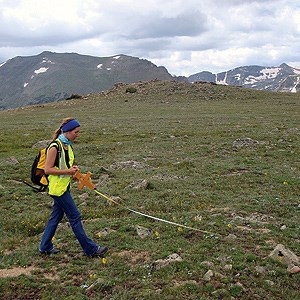
NPS photo
For the National Park Service to fulfill its mission to "conserve the scenery and the natural and historic objects and the wild life therein and to provide for the enjoyment of the same in such a manner and such a means as will leave them unimpaired for future generations," we must have access to high quality science. Our decisions will be based on the best available climate change science, including scientific knowledge gathered from other agencies and institutions, and National Park Service (NPS) conducted scientific activities.
The science used by the Climate Change Response Program will be directed toward better stewardship and will treat NPS units and surrounding areas as coupled human-ecological systems. Our approach will focus on small and large scales, synthesize existing research, inventory resources, monitor conditions, and deliver this information to park managers and park partners to support decision-making. The outcomes will also be shared with park employees and the general public.
National parks and other protected areas offer laboratories for climate science. They encompass some of most pristine lands in the country, including areas that remain relatively free of human influence. Many have been studied and monitored for years. In many cases these areas provide the best baselines from which to study the complex interactions of natural systems. In addition to studying these natural processes, our cultural and archeological sites give us insight into how people have affected and responded to changes in their environments in the past.
The longevity and health of our national parks will depend heavily on park managers' ability to access and apply sound science to preserving these lands entrusted to them by the American people. Four goals will guide climate change science:
- Use the best available scientific data and knowledge to inform decision making in regard to climate change. Expertise and knowledge on climate change is spread across different agencies, institutions and organizations. Such science needs to be collected with an efficient data system, used to train NPS staff, and integrated into all relevant aspects of park management. We will retain the full context of scientific information, including assumptions, uncertainty, limitations, and competing hypotheses.
- Collaborate with partners to develop, test, and distribute the best results from climate change models to inform NPS activities. The NPS has an extensive library of ecosystem understanding, natural resource vital signs, and a monitoring framework that can be used to identify which park attributes are sensitive to climate change. We must also evaluate the latest climate change models to see which geographic areas and parks are most likely to experience relatively rapid changes. The NPS will build climate modeling expertise to evaluate and interpret the results, and such information will be distributed to park scientists and managers.
- Inventory and monitor key attributes of natural and cultural resources, and the visitor experiences likely to be impacted by climate change. Parks scientists will evaluate and revise where necessary the existing cultural and natural resource inventory and monitoring programs to detect climate change effects. Using these data, scientists will develop and validate methods to assess the vulnerability of cultural resources, natural resources, social and economic systems, and surrounding communities to climate change impacts. With scientific partners, we will develop criteria to measure key concepts such as resilience that are essential in our adaptation strategies.
- Acquire, provide, and apply scientific information to reduce the National Park Service's carbon footprint. The NPS will begin greenhouse gas accounting for the entire system of parks and offices and seek new ways to reduce the emission of CO2 as well as evaluate the consequences of bio-sequestration on park lands.
Last updated: July 7, 2021
